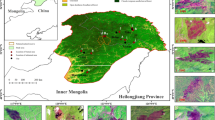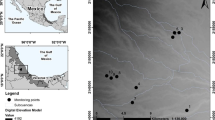Abstract
The present study evaluates indicators in Swedish spruce forests. We ask whether different species groups co-vary in their occurrence and to what extent species richness and composition is predictable from habitat structures. We studied 10 boreal spruce forest stands constituting a gradient in degree of selective logging. Occurrences of vascular plants, bryophytes, epiphytic lichens and wood-inhabiting fungi as well as habitat structures was inventoried. In addition, in five of the stands, beetles were sampled with windows traps. Total species richness was correlated with several habitat factors, mainly particular substrates and degree of forestry impact. However, the richness of a set of species regularly used as indicators did not correlate with habitat factors. Correlation in species richness among different organism groups were few and scale dependent. Only lichens and vascular plants formed nested subset patterns (i.e. species composition at poorer sites is subsets of the species present at richer sites) among the study sites. The study shows that in this forest type one cannot a priori assume that richness in one group of species correlated with richness in other, and measures of single habitat features may be relevant only to particular groups of species. Instead, monitoring and inventories should be based on a set of factors reflecting important aspects for different groups of organisms and if indicator species are to be used these should be chosen from several species groups.
Similar content being viewed by others
References
Ahti T, Hämet-Ahti L and Jalas J (1968) Vegetation zones and their sections in northwestern Europe. Ann. Bot. Fenn. 5: 169–211
Angelstam P (1997) Towards a logic for assessing biodiversity in boreal forest. In: Bachmann P, Köhl M and Päivinen R (eds) Assessment of Biodiversity for Improved Forest Planning. Kluwer Academic Publishers, Dordrecht, The Netherlands
Anonymous (1994) Skogsvårdslagen, Handbok. Swedish Forestry Board, Jönköping
Aronsson M, Hallingbäck T and Mattsson L-E (1995) Rödlistade växter i Sverige 1995. ArtDatabanken, SLU, Uppsala
Bader P, Jansson S and Jonsson BG (1995) Wood-inhabiting fungi and substratum decline in selectively logged boreal spruce forests. Biol. Conserv. 72: 355–362
Berg Å, Ehnström B, Gustavsson L, Hallingbäck T, Jonsell M and Weslien J (1994) Threatened plant, animal, and fungus species in Swedish forests: distribution and habitat associations. Conserv. Biol. 8: 718–731
Berg Å, Ehnström B, Gustavsson L, Hallingbäck T, Jonsell M and Weslien J (1995) Threat levels and threats to red-listed species in Swedish forests. Conserv. Biol. 9: 1629–1633
Bernes C (ed) (1994) Biodiversity in Sweden. Monitor 14. Swedish Environmental Protection Agency, Solna.
Cutler A (1991) Nested faunas and extinction in fragmented habitats. Conserv. Biol. 4: 496–505
Ebeling F (1978) Nordsvenska skogstyper. Sveriges Skogsvårdsf. Tidsk. 4: 340–381
Ehnström B, Gärdenfors U and Lindelöw Å (1993) Rödlistade evertebrater i Sverige 1993. ArtDatabanken, SLU, Uppsala
Eriksson et al. (1973–1987) The Corticiaceae of North Europe. Fungiflora, Oslo
Fries C, Johansson O, Pettersson B and Simonsson P (1997) Silvicultural models to maintain and restore natural stand structures in Swedish boreal forests. Forest Ecology and Management 94: 89–103
Gleason HA (1926) The individualistic concept of the plant association. Bull. Torrey Bot. Club 53: 7–26
Hansen V (1964) Fortegnelse over Danmarks biller 1. og 2. del. Entomologiske Meddelelser 33: 1–507
Harding PT and Rose F (1986) Pasture-woodlands in lowland Britain. NERC Institute of Terrestrial Ecology, Huntingdon
Jongman RHG, ter Braak CJF and van Tongeren OFR (1995) Data Analysis in Community and Landscape Ecology. Cambridge University Press, Cambridge
Kadmon R (1995) Nested species subsets and geographic isolation: a case study. Ecology 76: 458–465
Karlsson T (1998) The vascular plants of Sweden – a checklist. Svensk Bot. Tidskr. 91: 241–560
Kohm KA and Franklin JF (1996) Creating a Forestry for the Twenty-First Century. Island Press, USA
Kruys N and Jonsson BG (1997) Insular patterns of calicioid lichens in a boreal old-growth forest-wetland mosaic. Ecography 20: 605–613
Lämås T and Fries C (1995) Emergence of a biodiversity concept in Swedish forestry policy. Water, Air, nd Soil Pollution 82: 57–66
Landres PB, Verner J and Thomas JW (1988) Ecological uses of vertebrate indicator species: a critique. Conserv. Biol. 2: 316–328
Lomolino MV (1996) Investigating causality of nestedness of insular communities: selective immigrations or extinctions? J. Biogeog. 23: 699–703
Lundberg S and Gustavsson B (1995) Catalogus Coleopterorum Sueciae. Naturhistoriska riskmuseet, Stockholm
McCune B and Mefford MJ (1995) PC-ORD. Multivariate analysis of ecological data, version 2.0. MjMSoftware Design, Gleneden Beach, OR
McGeoch MA (1998) The selection, testing and application of terrestrial insects as bioindicators. Biol. Rev. 73: 181–201
Nilsson SG, Arup U, Baranowski R and Ekman S (1995) Tree-dependent lichens and beetles as indicators in conservation forests. Conserv. Biol. 9: 1208–1215
Nilsson SG and Baranowski R (1997) Habitat predictability and the occurrence of wood beetles in oldgrowth beech forests. Ecography 20: 491–498
Nitare J and Norén M (1992) Nyckelbiotoper kartläggs i nytt projekt vid Skogsstyrelsen. Svensk Bot. Tidskr. 86: 219–226
Noren M, Hultgren B, Nitare J and Bergengren I (1995) Datainsamling vid inventering av nyckelbiotoper. Skogstyrelsen, Jönköping
Noss RF (1990) Indicators for biodiversity: A hierarchical approach. Conserv. Biol. 4: 355–364
Økland B, Bakke A, Hågvar S and Kvamme T (1996) What factors influence the diversity of saproxylic beetles? A multiscaled study from a spruce forest in southern Norway. Biodiversity and Conservation 5: 75–100
Palm T (1951) Die Holz und Rindenkäfer der nordschwedische Laubbäume. Meddelanden från statens skogsforskningsinstitut 40: 1–242
Palm T (1959) Die Holz und Rindenkäfer der Süd-und Mittelschwedischen Laubbäume. Opuscula Entomologica Supplementum 16: 1–374
Patterson BD and Atmar W (1986) Nested subsets and the structure of insular mammalian faunas and archipelagos. In: Heaney LR and Patterson BD (eds) Island Biogeography of Mammals, pp 65–82.Biological Journal of the Linnean Society 28 Academic Press and Linnean Society of London, UK
Patterson BD (1987) The principle of nested subsets and its implication for biological conservation. Conserv. Biol. 1: 323–334
Patterson BD (1990) On the temporal development of nested subset patterns of species composition. Oikos 59: 330–342
Prendergast JR, Quinn RM, Lawton JH, Eversham BC and Gibbons DW (1993) Rare species, the coincidence of diversity hotspots and conservation strategies. Nature 365: 335–337
Rose F (1992) Temperate forest management: its effects on bryophyte and lichen floras and habitats. In: Bates JW and Farmer AM (eds) Bryophytes and Lichens in a Changing Environment, pp 211–233. Oxford University Press, Oxford
Ryvarden L and Gilbertson RL (1993–1994) European Polypores, Part 1. Fungiflora, Oslo
Santesson R (1993) The Lichens and Lichenicolous Fungi of Sweden and Norway. SBT-förlaget, Lund
Siitonen J and Martikainen P (1994) Occurrence of rare and threatened insects living on decaying Populus tremula: A comparison between Finnish and Russian Karelia. Scand. J. For. Res. 9: 185–191
Simberloff D (1979) Rarefaction as a distribution-free method of expressing and estimating diversity. In: Grassle JF, Patil GP, Smith W and Taillie C (eds) Ecological Diversity in Theory and Practice, pp 159–176. International Co-operative Publishing House, Fairland, MD
Simberloff D (1998) Flagships, umbrellas, and keystones: Is single-species management passe in the landscape era? Biol. Conserv. 83: 247–257
Söderström L (1988) The occurrence of epixylic bryophytes and lichen species in an old natural and a managed forest stand in northeast Sweden. Biol. Conserv. 45: 169–178
Söderström L and Hedenäs L (1998) Checklista över Sveriges mossor – 1998. Myrinia 8: 58–90
Speight MCD (1989) Saproxylic Invertebrates and Their Conservation. Council of Europe, Strasbourg ter
Braak CJF and Prentice IC (1987) A theory of gradient analysis. Adv. Ecol. Res. 18: 271–317
Author information
Authors and Affiliations
Rights and permissions
About this article
Cite this article
Jonsson, B.G., Jonsell, M. Exploring potential biodiversity indicators in boreal forests. Biodiversity and Conservation 8, 1417–1433 (1999). https://doi.org/10.1023/A:1008900309571
Issue Date:
DOI: https://doi.org/10.1023/A:1008900309571




